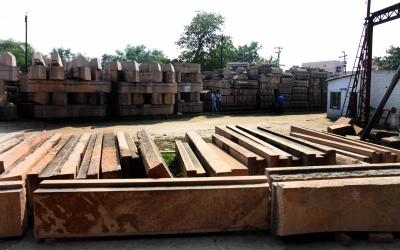Harmony resides in these lanes of Ayodhya
By IANS | Published: November 21, 2019 03:34 PM2019-11-21T15:34:05+5:302019-11-21T17:15:06+5:30
Hindu seers and Muslim clerics may continue with their one-upmanship over the Ram Janambhoomi issue, but inside the lanes of Ayodhya, harmony breeds between the two communities.

Harmony resides in these lanes of Ayodhya
Muslims stitching clothes for Hindu deities, participating in Ram Lila and 'Ram Baraat' and selling items for 'puja in Ayodhya is as common as Hindus contributing to mosque renovation or helping fellow Muslims in times of need.
For years, Sadiq Ali, a tailor, had stitched clothes for Ram Lalla, the deity at the makeshift Ram Janambhoomi temple.
Sadiq Ali was replaced a few years ago with another tailor by the chief priest of the Ram Janambhoomi temple Acharya Satyendra Das.
Satyendra Das, when contacted, refused to comment on why Sadiq was removed from his job but said that he tailored 'perfect clothes' for the Lord.
"It was under pressure from some fundamentalist leaders that I was removed," said Sadiq, who is now 59 years old.
His shop, Babu Tailors, is located on land that belongs to the Hanuman Garhi temple.
After he was removed as Ram Lalla's tailor, Sadiq and a group of local people even made efforts to resolve the Ayodhya dispute.
"We had even given a proposal to the Commissioner that the temple can be constructed on the same land while the mosque can be built about half a kilometer away. We are unhappy that the Supreme Court has not identified the place where the mosque is to be built," he said on phone.
Sadiq Ali and his son have also been stitching clothes for Hindu priests and saints. He has made 'sadri' (waistcoat) for all petitioners in the Ram Temple-Babri Masjid dispute right from the days of Mahant Ramchandra Das Paramhans to the recent heads of Hanuman Garhi Temple and Kanak Bhawan.
Roxy, another Muslim tailor in Ayodhya had also stitched the cloth to cover Ram Lalla's idol to protect it against pigeon droppings.
He stitched the tarpaulin that is put up at the temple.
Roxy, however, has not stitched clothes for Ram Lalla though he has made clothes for idols in other temples in the past.
His son Shaan, says, "We don't stitch clothes for gods anymore because payment is always an issue."
Mohammed Salim, a devout Muslim, has been making 'khadaun' (wooden sandal), which are traditionally worn by saints and seers. These wooden slippers are also given as offerings in temples.
His family has been in the business since several generations.
"The 'khadauns' we make are purchased by temples and seers. I have never witnessed any tension between the two communities here. We depend on each other for our needs and we respect each other," he said.
In another example of inter-faith harmony, there is Abdul Wahid, a welder, whose services are taken to repair the sharp barbed wires that secure the Ram Janambhoomi site get broken.
Wahid, equipped with arc welders, plasma cutters, gas and rods, helps in maintaining the temple's security for Rs 250 per day. He says he gets joy from the task he performs.
His friend, Mehboob, also helps in serving temples. He had first brought a three-phase motor that excavated underground water near Sita Kund for the community kitchen at Ram Janambhoomi in 1995.
Since then, Mehboob has been a regular feature at most temples in the town to look after electricity works. He also ensures that the site where the Ram Lalla idol is kept, remains lit round-the-clock.
At the Haridwari Bazaar in Ayodhya, there are more than five shops, owned by Muslims, selling items for Hindu religious events and pujas.
Reshma, the fourth generation member running the shop, said, "It is not about religion it is about livelihood. If I can manage good sales, I can look after my family better."
Mohd Ashhar, a Muslim resident in Ayodhya, said that he and his family felt secure in the temple town even during troubled times because of his Hindu neighbours.
"When the riots broke out in 1992 after the demolition, it was my Hindu neighbours who took care of us. They regularly sent food for my family and made sure that we did not venture out of the house till things settled down. I have never thought of moving out of Ayodhya mainly because of this," he said.
Hindus, on their part, have helped in the renovation of a mosque near Hanuman Garhi temple.
Both the communities are unanimous in their opinion that troublemakers in the holy city are invariably outsiders.
"Ayodhyavasis (residents of Ayodhya) are truly secular and will always remain so," said Mohd Ashhar.
( With inputs from IANS )
Open in app